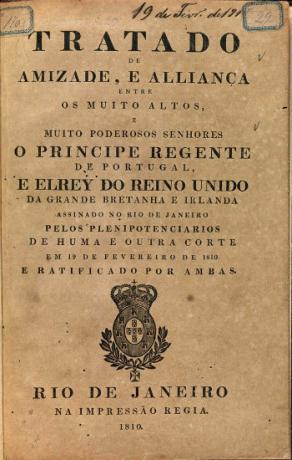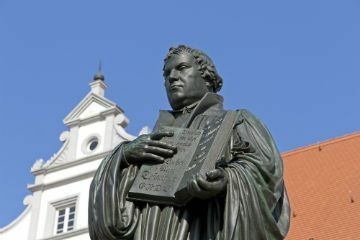THE coming of the Portuguese royal family to Brazil it took place on November 29, 1807 and the delegation arrived in Salvador (BA) on January 22, 1808.
The refuge in Brazil was a maneuver by the prince regent, D. João, to ensure that Portugal remained independent when it was threatened with invasion by Napoleon Bonaparte.
To ensure the success of the transfer, the kingdom of Portugal had support from England, which also helped in the expulsion of Napoleonic troops.
Why did the Royal Family come to Brazil?
In 1806, Napoleon Bonaparte decreed the continental blockade, ordering European countries to close their ports to England's ships.
Meanwhile, Bonaparte secretly negotiated the Treaty of Fontainebleau (1807) with the Spaniards that would allow the French to cross Spain to invade Portugal. In exchange, the Spanish kingdom could seize a piece of Portuguese territory.
Portugal did not join the continental blockade due to the long political and commercial alliance with the English and, for this reason, Napoleon ordered the invasion of Portuguese territory, which took place in November 1807.
Before that, on October 22, 1807, Prince Regent D. João and the King of England Jorge III (1738-1820) signed a secret convention that transferred the seat of monarchy from Portugal to Brazil.
In this same document, it was established that British troops would temporarily settle on the island of Madeira. For its part, the Portuguese government undertook to sign a commercial treaty with England after settling in Brazil.
the prince regent, Dom João, determined that the entire royal family would be transferred to Brazil. Ministers and employees would also travel, totaling 15.7 thousand people representing 2% of the Portuguese population.
These numbers are currently being revised as many historians consider the figure to be exaggerated.
Royal Family Boarding

It took eight ships, three frigates, three brigs and two schooners for transport. Another 4 ships of the British fleet accompanied the court.
In addition to the people, on November 29, 1807, furniture, documents, money, works of art and the royal library were also shipped. Those who remained were advised to receive the invaders peacefully to avoid bloodshed.
General Junot (1771-1813), commander of the invasion, stayed in Lisbon until August 1808, when he was defeated by the British. From then onwards, Portugal was governed by the Regency Council made up of noblemen from the kingdom.
Crossing and arrival of the Royal Family
The trip took place in unhealthy conditions and lasted 54 days to Salvador (BA), where he disembarked on January 22, 1808. In the capital of Bahia, they were received with parties and stayed there for over a month.
During the period in which he was in Bahia, the Prince Regent signed the Treaty for the Opening of Ports to Friendly Nations and created the School of Surgery of Bahia.
On February 26, the court left for Rio de Janeiro, which would be declared the capital of the Empire.
The arrival in Rio de Janeiro took place on March 8, 1808. There were few lodgings available to accommodate the palatial entourage and many residences were requested to receive them. Barracks and convents were also used to accommodate the court.
The houses that were chosen by the nobles received the inscription P.R. on their facade, which meant "Prince Regent" and indicated the departure of the residents to make the property available.
However, the population interpreted the acronym, ironically, as "Put yourself on the street".
Consequences of the coming of the Royal Family
The transfer of the Royal Family and its entourage contributed to significant changes in Brazil and Rio de Janeiro.
With the opening of the ports, all nations friendly to Portugal were able to trade with Brazil. At first, this meant trading with England.
In turn, Rio de Janeiro became the capital of the kingdom of Portugal and improvements and new public buildings were carried out in the city.
The same happened with furniture and fashion. With the opening of the ports, commerce was diversified, starting to offer services such as hairdressers, hatters, dressmakers.
D. João also opened the Imprensa Régia, from which the Gazeta do Rio de Janeiro emerged. Institutions such as:
- Royal Military Academy (1810),
- Botanical Garden (1808),
- Royal Gunpowder Factory (1808),
- Banco do Brasil (1808),
- Chemical-Practical Laboratory (1812).
cultural life
Art, however, is among the sectors that received the greatest impact from the transfer of the court. The Royal Library of Portugal was transferred from Lisbon to Rio de Janeiro in 1810.
The initial collection, of 60 thousand volumes, consisted of books, maps, manuscripts, prints and medals and was the origin of the current National Library.
For the entertainment of the members of the court, the Real Teatro São João was founded in 1813, where the Teatro João Caetano is currently located.
In music, the Portuguese composer Marcos Portugal and the Brazilian Father José Maurício wrote at the time the most beautiful melodies in the Americas.
With the end of Napoleonic Wars, several French artists found themselves out of work and turned to Dom João to pursue their careers. Thus begins the so-called French Mission, which enabled the opening of the Royal School of Arts, Sciences and Crafts.
Treaty of Alliance and Friendship, of Commerce and Navigation

In order to strengthen commercial and political ties with the British, Dom João signed, in 1810, the Treaty of Alliance and Friendship, of Commerce and Navigation with the United Kingdom.
This Treaty established:
- commercial advantages. The import tax on English products would be 15%, that is, Portuguese products, 16%, and other countries, 24%.
- The commitment to end the slave trade in view of the abolition of slavery;
- the right of extraterritoriality. This allowed English subjects who committed crimes in Portuguese domains to be prosecuted by English magistrates under English law;
- permission to build cemeteries and Protestant temples;
- the assurance that the Inquisition would not be implanted in Brazil and, in this way, the Protestants would not be disturbed.
Independence of Brazil
The main consequence of the arrival of the royal family in Brazil was the acceleration of the country's independence process.
In 1815, with the end of the Napoleonic Wars, Brazil was declared part of the United Kingdom of Portugal and Algarves, ceasing to be a colony.
This was necessary, as the European leaders gathered at the Congress of Vienna did not recognize Dom João's authority in a simple overseas possession.
The permanence of the royal family was decisive in maintaining Brazil's territorial unification, as it gathered part of the elite and the population around the figure of the sovereign.
Dom João's political-administrative measures led England to increase its interest in trade with Brazil. This condition becomes clear with the opening of ports to friendly nations.
The process caused Portugal to lose its monopoly on trade with Brazil and the agrarian elite began to dream of independence. On the other hand, Brazil becomes for England a promising consumer and supplier market.
When D. João VI had to return to Portugal, because of the Porto Liberal Revolution, the son Dom Pedro, approaches the agrarian elite. This was concerned with the possibility of recolonization and the ongoing wars in Spanish America.
The Independence of Brazil is declared on September 7, 1822 by Dom Pedro I who becomes the first emperor of Brazil.
Independent, the country promulgates the first Constitution in 1824 that maintains the monarchic regime, slavery and recognizes the Catholic religion as official.
Summary of the coming of the Royal Family
| Historical Fact | Date |
|---|---|
| Continental Lock | November 21, 1806 |
| Departure from Lisbon | November 29, 1807 |
| Arrival in Bahia | 22 January 1808 |
| Opening of Ports for Friendly Nations | January 28, 1808 |
| Creation of the Bahia School of Surgery | February 18, 1808 |
| Arrival in Rio de Janeiro | March 8th 1808 |
| Creation of the Royal Press | May 13, 1808 |
| Royal Academy of Marine Guards | May 5, 1808 |
| Establishment of the Real Horto (Botanical Garden) | June 13, 1808 |
| Banco do Brasil Foundation | October 12, 1808 |
| Alliance and Friendship, Trade and Navigation Treaties | February 19, 1810 |
| Institution of the Royal Library (current National Library) | October 29, 1810 |
| Royal Military Academy | December 4, 1810 |
| Chemical-Practical Laboratory | January 25, 1812 |
| São João Theater | October 13, 1813 |
| Creation of the French Mission | 1815 |
| Royal School of Arts, Sciences and Crafts | August 12, 1816 |
| Return to Portugal | April 26, 1821 |
Read more:
- Independence of Brazil
- day of stay
- Maria Quiteria
- Brazilian History Questions in Enem


